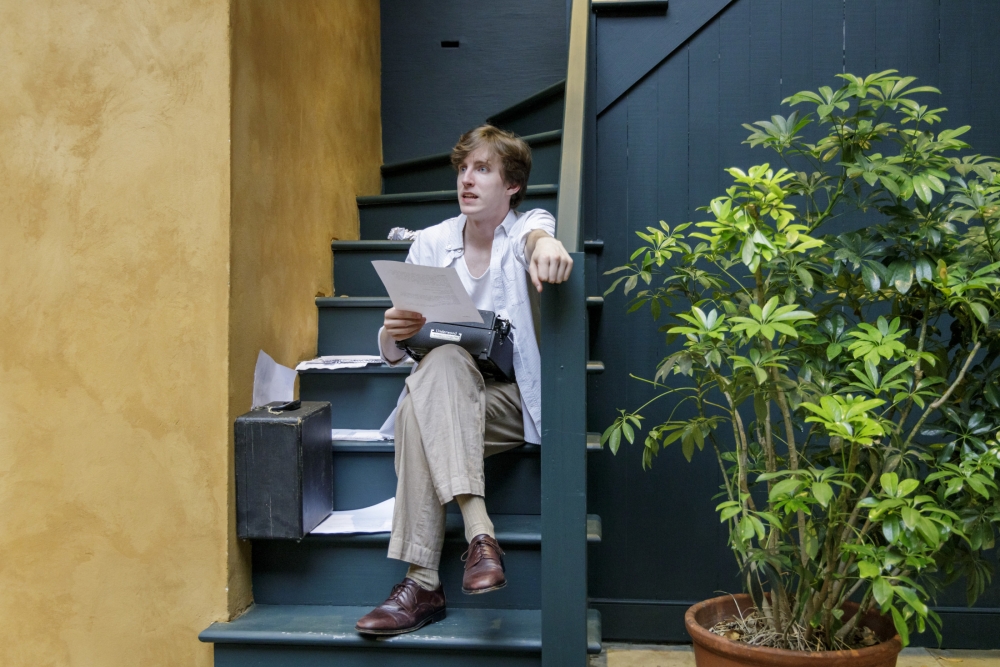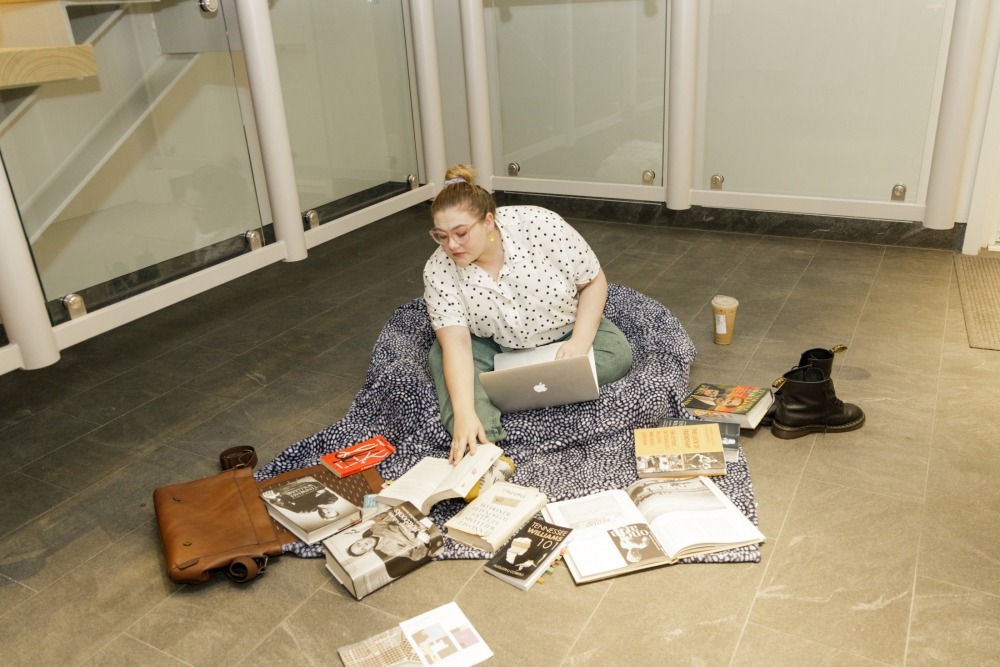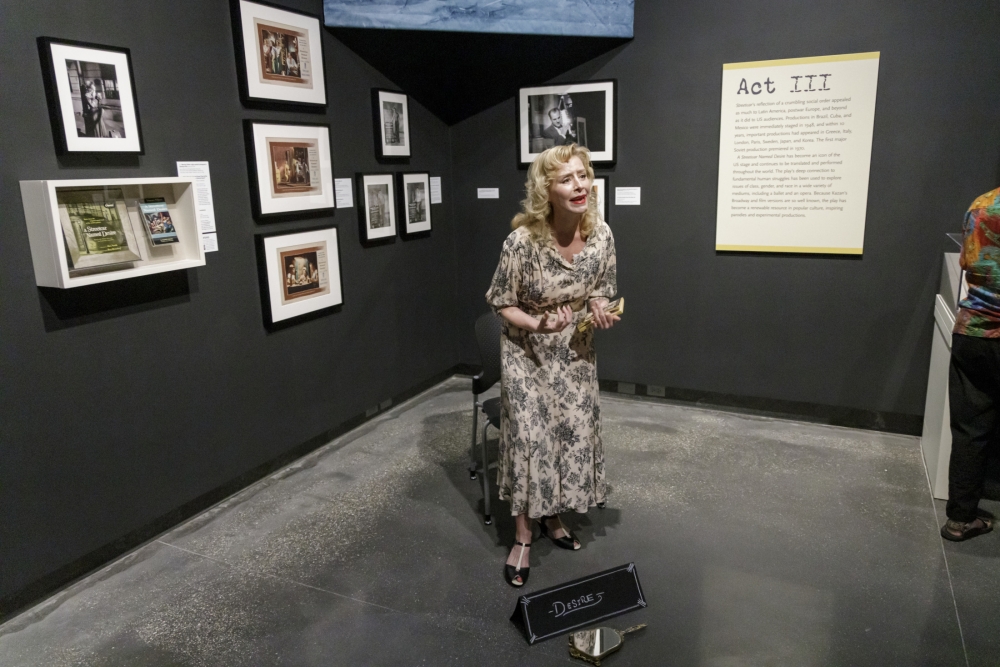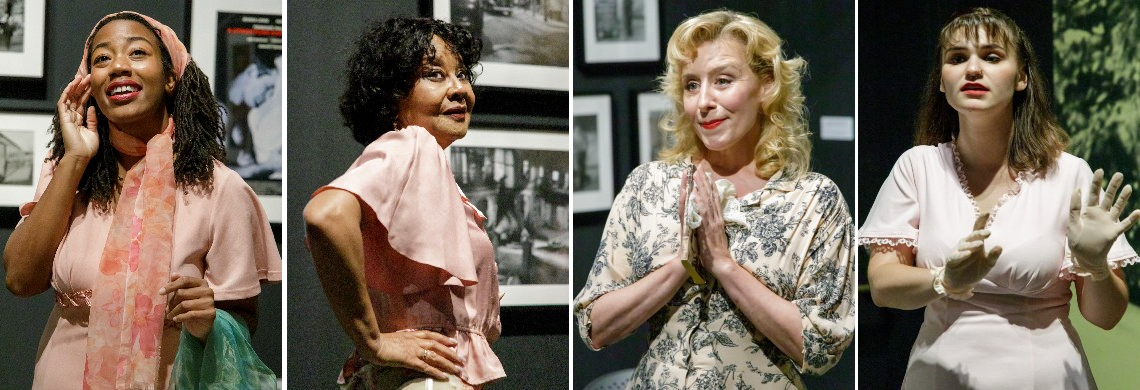In May 2022, The Tennessee Williams Theatre Company partnered with The Historic New Orleans Collection and Loyola University New Orleans’s Department of Theatre Arts and Dance to stage The Six Blanches, an original performance inspired by and set in THNOC’s exhibition Backstage at “A Streetcar Named Desire.”
An immersive theater experience, The Six Blanches presented audiences with six actors playing Blanche DuBois, each one focused on a different facet of the tragic heroine’s character—Grief, Magic, Tenderness, Panic, Desire, and Fantasy. The writer and director of the project, Augustin Correro, adapted the text from the Tennessee Williams play, compiling what he calls “repetitions”—collections of lines that the actors could loop in any manner or order they chose.
Through the exploration of these short excerpts from the play, the Blanches illuminated the different aspects of the iconic character and helped visitors better understand what makes the heroine tick. Audiences were able to roam the exhibit, visiting the Blanches and the exhibition artifacts in whatever order they chose. They could return to a previous Blanche once they’d seen others, in order to make a more thorough and meaningful connection with the character.
Playing the six Blanches were Loyola University New Orleans students Anja Avsharian, Emily Patrick, Roya Scott, and Zane Syjansky, as well as local professional actors Jaclyn Bethany, Gwendolyn Foxworth, Lin Gathright, and Xel Simone.
THNOC sat down with Correro, who serves as coartistic director of the Tennessee Williams Theatre Company, to discuss the creation of The Six Blanches and what inspiration he drew from Backstage at “Streetcar.”

Zane Syjansky, as Writer, a stand-in for Tennessee Williams, sits on the Brulatour Coutyard steps with a typewriter and manuscript. (Photograph by THNOC Assistant Photographer Amber Johnson)
What was the seed of your inspiration for The Six Blanches?
I was first drawn to the concept in initial meetings with THNOC staff about what type of program would best harmonize with the Backstage at “A Streetcar Named Desire” exhibit. When the exhibit was described to me, I imagined a staging in which live actors would supplement the artifacts as a part of the installation. The idea of multiple versions of the same actor preparing backstage came to me, and I envisioned visitors stopping to see the text come alive, then reflecting on what they have learned before moving to the next case or frame.
Other than the fact that she is the central character in the play, why did you focus solely on Blanche?
It would have been somewhat messy to have a hodgepodge of characters from the play scattered about the room, to my thinking. Rather than characters competing for space in the audience’s imagination, what better way to do a deep dive and explore the relationships of the protagonist than to dissect and separate her and see what makes her tick? This is to say nothing of the depth of the character that is laid out in the text, which no other character in the play has. Williams, having put down more material for Blanche than for, say, Stanley or Stella or Eunice, has provided us a much more elaborate field of study. And after all, it’s the text we return to for our source as theater makers—it’s our most valuable resource.

Surrounded by books on the floor of the Tricentennial Wing, Emily Patrick plays Researcher in a nod to the Tennessee Williams scholarly community. (Photograph by Amber Johnson)
What artifacts in the exhibition did you use in devising the process?
I spent a few hours in the exhibition prior to rehearsals deciding what we were meant to augment in the performance. Some of the pieces that stood out to me were the editions of the text in various languages, the typewriter, and the painting Poker Night by Thomas Hart Benton. They all stood out to me to remind viewers that there is no one monolithic portrayal of Blanche, and that each audience member can see something different reflected in an actor’s portrayal of her. I also loved the video element supplementing the artifacts, since its dreamy, sometimes nightmarish use of colors and distortion uplift Williams’s magical realism.
Did you use any source materials from The Collection’s archives?
For our work as theater makers, we tend to use the text as our North Star, so it was important to us that we situate our performers—rooted in the text—amid the artifacts to provide additional context, rather than using the artifacts to color our treatment of the text. By doing so, we felt we were not shaping a commentary of the artifacts or vice-versa, but were aiming to amplify the exhibition’s educational and historical value, even if for a brief meeting.

Lin Gathright as Desire (Photograph by Amber Johnson)
Your company uses Tennessee Williams’s plays as an engine for artistic expression, and you’ve written a book about Williams (Tennessee Williams 101). As someone who is so immersed and well versed in his works, did you learn anything about Blanche from this process?
I think I learned the most about Blanche from the actors and the happy coincidences that took place in the rehearsal room and the performance space. Wandering the gallery, you might hear Blanches from across the room deliver the same line in the same moment (completely by accident), and I’d make connections as to how her grief informs her desire, or that her need to live in a fantasy is informed by her panic, and so on. It definitely helped me to have a fuller understanding of Blanche’s tenuous relationship with the truth and her own motivations.
Which of these Blanches would you most likely invite to a dinner party?
Panic, because she’s so anxious I just know she wouldn’t break any of the dishes or glassware.












